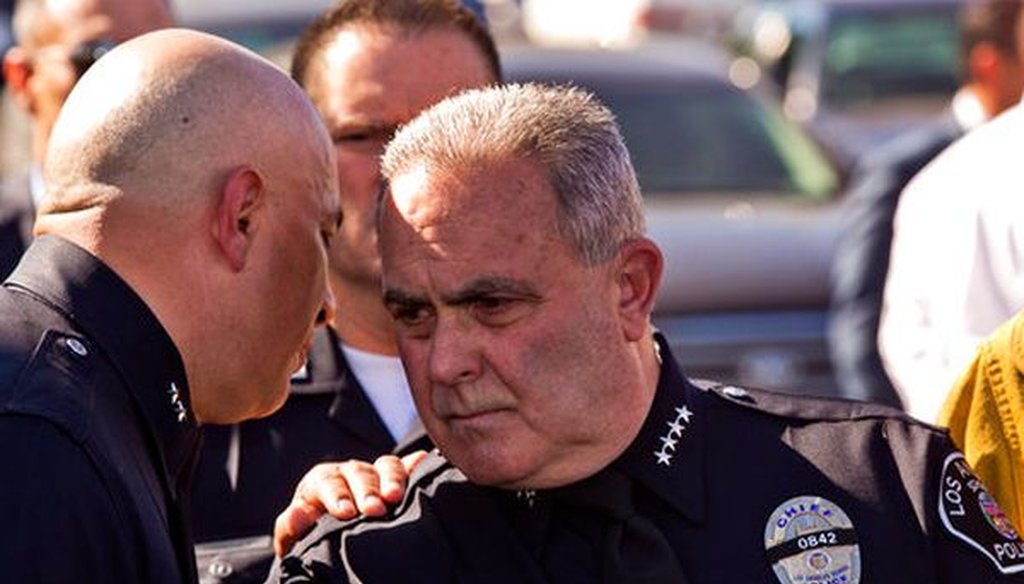Stand up for the facts!
Our only agenda is to publish the truth so you can be an informed participant in democracy.
We need your help.
I would like to contribute
Bill that would ease gun-carrying rights in schools passed House in December

Steve Zipperman, chief of the Los Angeles Unified School District police force, right, is briefed outside the Belmont High School complex on Feb. 1, 2018, after two students were shot and wounded, one critically, inside a Los Angeles middle school.
During the 2016 presidential campaign, Donald Trump pledged to eliminate gun-free zones at schools and military bases.
One thing we should clarify right off the bat: The Pentagon actually eased rules for carrying guns on military bases before President Barack Obama left office.
A Defense Department directive released on Nov. 18, 2016, said that commanders "may grant permission to (Defense Department) personnel requesting to carry a privately owned firearm (concealed or open carry) on DoD property for a personal protection purpose not related to performance of an official duty or status."
That doesn't go quite as far as Trump suggested, but it still represented a significant easing of the rules. However, since it occurred before Trump took office, we'll primarily rate this promise based on any changes during Trump's presidency that affect gun free zones in schools.
As we noted in our previous update, there have been some legislative efforts in this area.
Rep. Thomas Massie, R-Ky., introduced a bill, the Safe Students Act, in the House to repeal the Gun-Free School Zones Act of 1990, on Jan. 3, 2017.
Nine days later, the House referred the bill to the Subcommittee on Crime, Terrorism, Homeland Security, and Investigations. However, there have been no further developments on the bill since then. More strikingly, the bill has garnered only a total of five cosponsors in the succeeding year, all of them Republicans. In fact, no lawmaker has signed on as a cosponsor since early February 2017.
A more successful legislative push came from the the Concealed Carry Reciprocity Act of 2017.
The headline provision of the bill would to allow qualified individuals to carry a concealed handgun into, or possess a concealed handgun in, another state as long as that state allows individuals to carry concealed firearms.
However, the impact of the law on the elements of Trump's promise is somewhat less sweeping.
Broadly, the bill says it would not supersede the laws of any state that restricts "the possession of firearms on any state or local government property, installation, building, base, or park."
Moreover, on the specific question of gun-carry rights in schools, the bill limits carrying rights to an "off-duty law enforcement officer" or a "qualified retired law enforcement officer" who is "authorized under such section to carry a concealed firearm."
On Dec. 6, 2017, the bill passed the House by a 231-198 margin. Only 14 Republicans voted against the bill, while just six Democrats voted for it.
After passage, the bill went to the Senate, where it was assigned to the Judiciary Committee. It has not yet advanced any further.
The fact that the House passed a bill that would loosen -- though not do away with -- gun restrictions in schools leads us to keep this promise at In the Works.
Our Sources
Congress.gov, main index page for H.R.38 - Concealed Carry Reciprocity Act of 2017, accessed Feb. 15, 2018
Roll call vote on H.R. 38, Dec 6, 2017
Congress.gov, main index page for H.R.34 - Safe Students Act, accessed Feb. 15, 2018
Defense Department, "DoD Directive 5210.56, Arming and the Use of Force," Nov. 18, 2016
Military.com, "DoD Releases Plan to Allow Personnel to Carry Firearms on Base," Nov. 21, 2016
